Sales Projection Report for Sports Equipment Company - Analysis
VerifiedAdded on 2023/01/11
|19
|5015
|70
Report
AI Summary
This report presents a comprehensive sales projection analysis for a sports equipment company. It delves into project management, emphasizing risk management strategies, including a detailed risk register with likelihood and response plans for regulatory, resource, team conflict, product fit, unit cost, and supply chain risks. The report also covers project time management, including planning, activity scheduling, resource allocation, and milestone identification. Project implementation is discussed using Kotter's 8-step change model and Greiner's growth cycle model. Furthermore, the report incorporates personal development aspects, including Gibb's reflective cycle, Belbin's team roles, and a personal development plan, offering a holistic view of business development and project execution. The report aims to provide a practical guide for students studying business development and project management.

Sales Projection
Paraphrase This Document
Need a fresh take? Get an instant paraphrase of this document with our AI Paraphraser
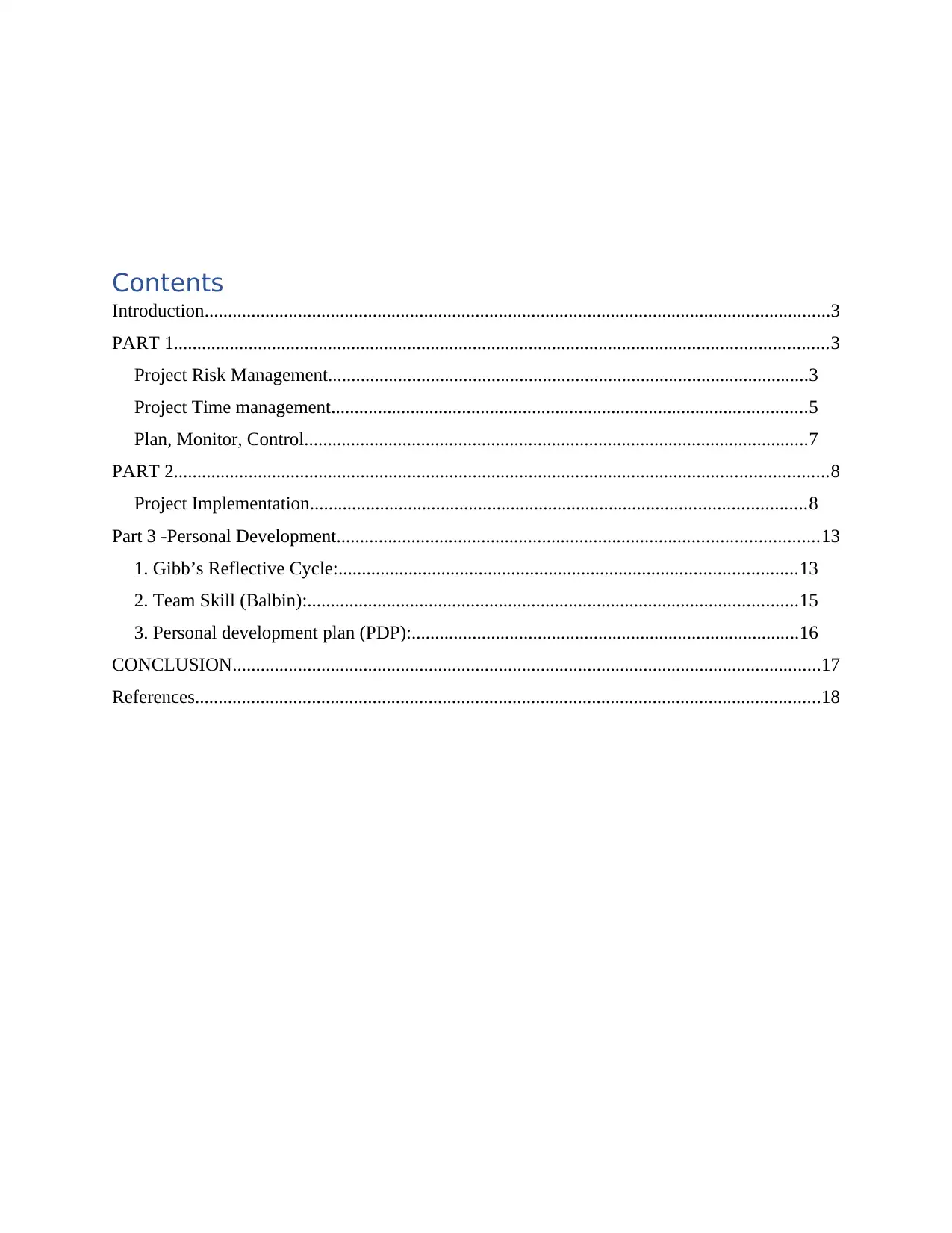
Contents
Introduction......................................................................................................................................3
PART 1............................................................................................................................................3
Project Risk Management.......................................................................................................3
Project Time management......................................................................................................5
Plan, Monitor, Control............................................................................................................7
PART 2............................................................................................................................................8
Project Implementation..........................................................................................................8
Part 3 -Personal Development.......................................................................................................13
1. Gibb’s Reflective Cycle:..................................................................................................13
2. Team Skill (Balbin):.........................................................................................................15
3. Personal development plan (PDP):...................................................................................16
CONCLUSION..............................................................................................................................17
References......................................................................................................................................18
Introduction......................................................................................................................................3
PART 1............................................................................................................................................3
Project Risk Management.......................................................................................................3
Project Time management......................................................................................................5
Plan, Monitor, Control............................................................................................................7
PART 2............................................................................................................................................8
Project Implementation..........................................................................................................8
Part 3 -Personal Development.......................................................................................................13
1. Gibb’s Reflective Cycle:..................................................................................................13
2. Team Skill (Balbin):.........................................................................................................15
3. Personal development plan (PDP):...................................................................................16
CONCLUSION..............................................................................................................................17
References......................................................................................................................................18
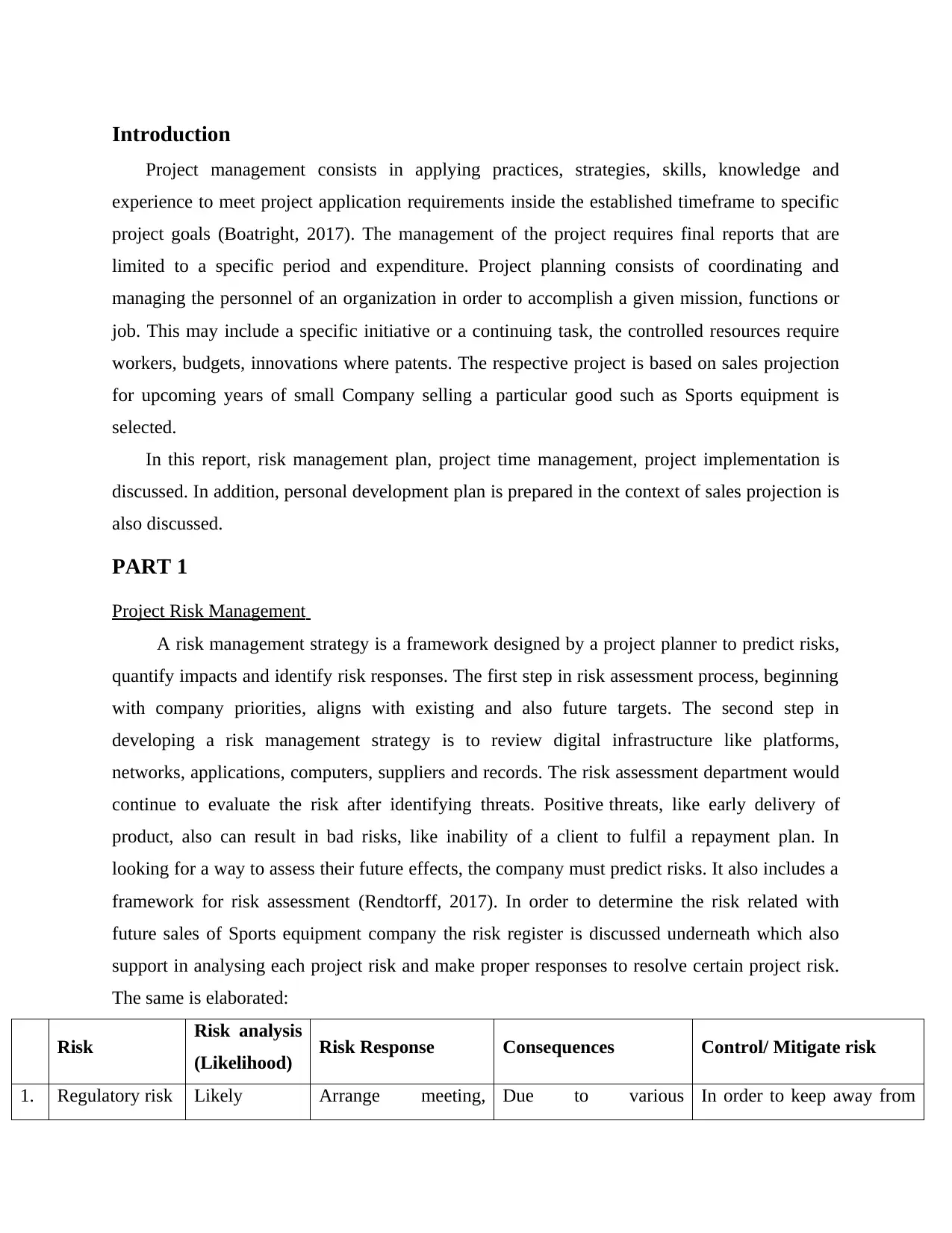
Introduction
Project management consists in applying practices, strategies, skills, knowledge and
experience to meet project application requirements inside the established timeframe to specific
project goals (Boatright, 2017). The management of the project requires final reports that are
limited to a specific period and expenditure. Project planning consists of coordinating and
managing the personnel of an organization in order to accomplish a given mission, functions or
job. This may include a specific initiative or a continuing task, the controlled resources require
workers, budgets, innovations where patents. The respective project is based on sales projection
for upcoming years of small Company selling a particular good such as Sports equipment is
selected.
In this report, risk management plan, project time management, project implementation is
discussed. In addition, personal development plan is prepared in the context of sales projection is
also discussed.
PART 1
Project Risk Management
A risk management strategy is a framework designed by a project planner to predict risks,
quantify impacts and identify risk responses. The first step in risk assessment process, beginning
with company priorities, aligns with existing and also future targets. The second step in
developing a risk management strategy is to review digital infrastructure like platforms,
networks, applications, computers, suppliers and records. The risk assessment department would
continue to evaluate the risk after identifying threats. Positive threats, like early delivery of
product, also can result in bad risks, like inability of a client to fulfil a repayment plan. In
looking for a way to assess their future effects, the company must predict risks. It also includes a
framework for risk assessment (Rendtorff, 2017). In order to determine the risk related with
future sales of Sports equipment company the risk register is discussed underneath which also
support in analysing each project risk and make proper responses to resolve certain project risk.
The same is elaborated:
Risk Risk analysis
(Likelihood) Risk Response Consequences Control/ Mitigate risk
1. Regulatory risk Likely Arrange meeting, Due to various In order to keep away from
Project management consists in applying practices, strategies, skills, knowledge and
experience to meet project application requirements inside the established timeframe to specific
project goals (Boatright, 2017). The management of the project requires final reports that are
limited to a specific period and expenditure. Project planning consists of coordinating and
managing the personnel of an organization in order to accomplish a given mission, functions or
job. This may include a specific initiative or a continuing task, the controlled resources require
workers, budgets, innovations where patents. The respective project is based on sales projection
for upcoming years of small Company selling a particular good such as Sports equipment is
selected.
In this report, risk management plan, project time management, project implementation is
discussed. In addition, personal development plan is prepared in the context of sales projection is
also discussed.
PART 1
Project Risk Management
A risk management strategy is a framework designed by a project planner to predict risks,
quantify impacts and identify risk responses. The first step in risk assessment process, beginning
with company priorities, aligns with existing and also future targets. The second step in
developing a risk management strategy is to review digital infrastructure like platforms,
networks, applications, computers, suppliers and records. The risk assessment department would
continue to evaluate the risk after identifying threats. Positive threats, like early delivery of
product, also can result in bad risks, like inability of a client to fulfil a repayment plan. In
looking for a way to assess their future effects, the company must predict risks. It also includes a
framework for risk assessment (Rendtorff, 2017). In order to determine the risk related with
future sales of Sports equipment company the risk register is discussed underneath which also
support in analysing each project risk and make proper responses to resolve certain project risk.
The same is elaborated:
Risk Risk analysis
(Likelihood) Risk Response Consequences Control/ Mitigate risk
1. Regulatory risk Likely Arrange meeting, Due to various In order to keep away from
⊘ This is a preview!⊘
Do you want full access?
Subscribe today to unlock all pages.

Trusted by 1+ million students worldwide
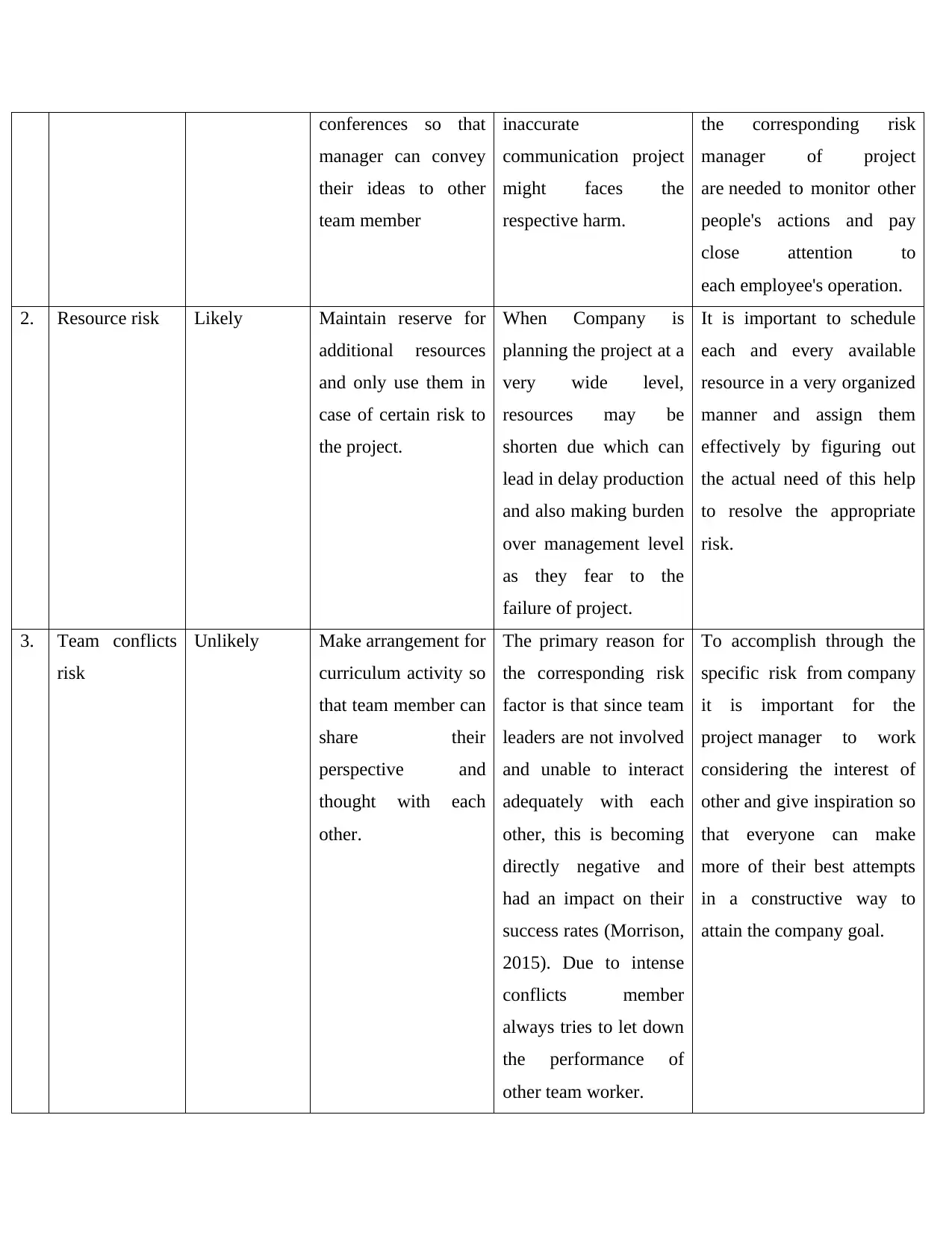
conferences so that
manager can convey
their ideas to other
team member
inaccurate
communication project
might faces the
respective harm.
the corresponding risk
manager of project
are needed to monitor other
people's actions and pay
close attention to
each employee's operation.
2. Resource risk Likely Maintain reserve for
additional resources
and only use them in
case of certain risk to
the project.
When Company is
planning the project at a
very wide level,
resources may be
shorten due which can
lead in delay production
and also making burden
over management level
as they fear to the
failure of project.
It is important to schedule
each and every available
resource in a very organized
manner and assign them
effectively by figuring out
the actual need of this help
to resolve the appropriate
risk.
3. Team conflicts
risk
Unlikely Make arrangement for
curriculum activity so
that team member can
share their
perspective and
thought with each
other.
The primary reason for
the corresponding risk
factor is that since team
leaders are not involved
and unable to interact
adequately with each
other, this is becoming
directly negative and
had an impact on their
success rates (Morrison,
2015). Due to intense
conflicts member
always tries to let down
the performance of
other team worker.
To accomplish through the
specific risk from company
it is important for the
project manager to work
considering the interest of
other and give inspiration so
that everyone can make
more of their best attempts
in a constructive way to
attain the company goal.
manager can convey
their ideas to other
team member
inaccurate
communication project
might faces the
respective harm.
the corresponding risk
manager of project
are needed to monitor other
people's actions and pay
close attention to
each employee's operation.
2. Resource risk Likely Maintain reserve for
additional resources
and only use them in
case of certain risk to
the project.
When Company is
planning the project at a
very wide level,
resources may be
shorten due which can
lead in delay production
and also making burden
over management level
as they fear to the
failure of project.
It is important to schedule
each and every available
resource in a very organized
manner and assign them
effectively by figuring out
the actual need of this help
to resolve the appropriate
risk.
3. Team conflicts
risk
Unlikely Make arrangement for
curriculum activity so
that team member can
share their
perspective and
thought with each
other.
The primary reason for
the corresponding risk
factor is that since team
leaders are not involved
and unable to interact
adequately with each
other, this is becoming
directly negative and
had an impact on their
success rates (Morrison,
2015). Due to intense
conflicts member
always tries to let down
the performance of
other team worker.
To accomplish through the
specific risk from company
it is important for the
project manager to work
considering the interest of
other and give inspiration so
that everyone can make
more of their best attempts
in a constructive way to
attain the company goal.
Paraphrase This Document
Need a fresh take? Get an instant paraphrase of this document with our AI Paraphraser
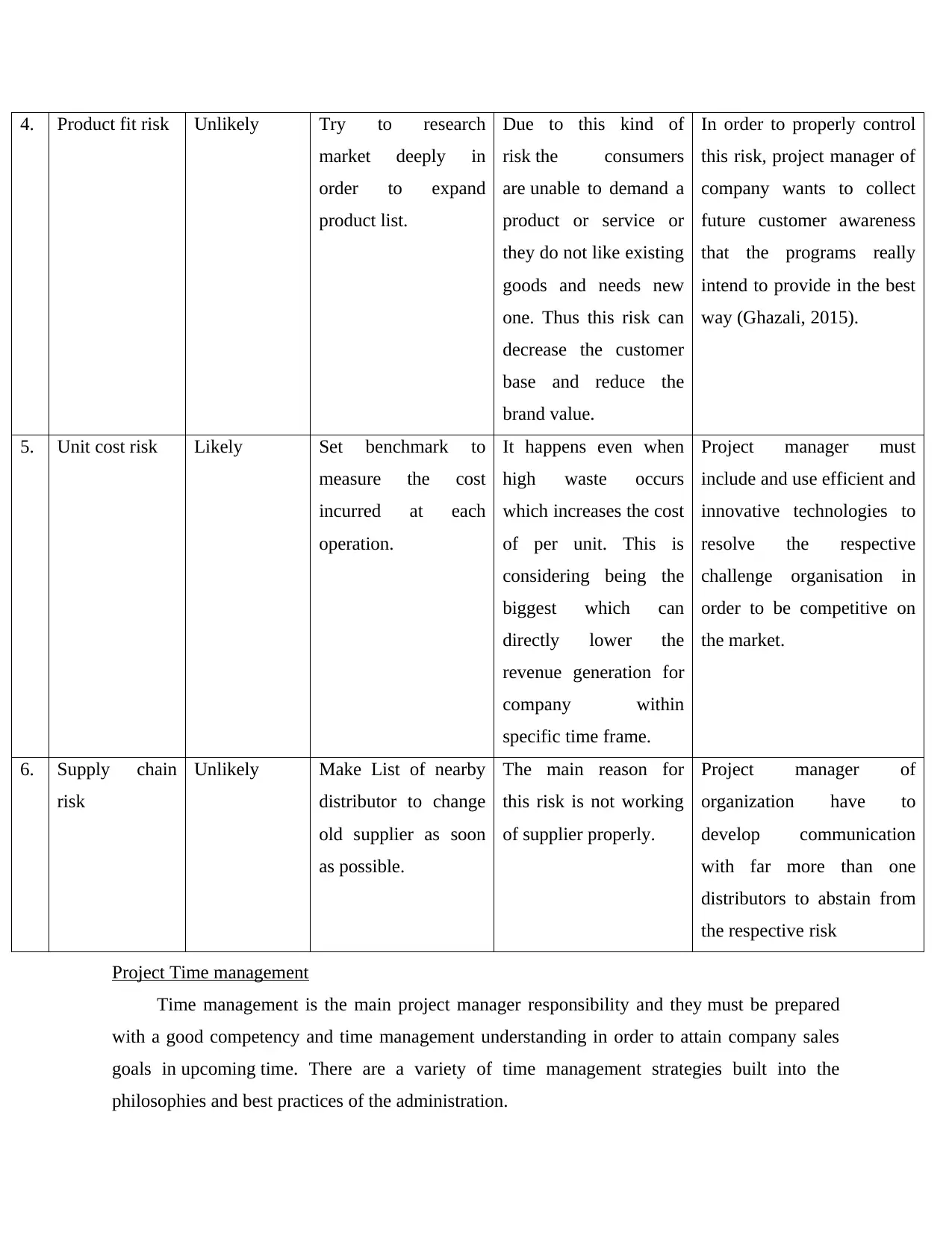
4. Product fit risk Unlikely Try to research
market deeply in
order to expand
product list.
Due to this kind of
risk the consumers
are unable to demand a
product or service or
they do not like existing
goods and needs new
one. Thus this risk can
decrease the customer
base and reduce the
brand value.
In order to properly control
this risk, project manager of
company wants to collect
future customer awareness
that the programs really
intend to provide in the best
way (Ghazali, 2015).
5. Unit cost risk Likely Set benchmark to
measure the cost
incurred at each
operation.
It happens even when
high waste occurs
which increases the cost
of per unit. This is
considering being the
biggest which can
directly lower the
revenue generation for
company within
specific time frame.
Project manager must
include and use efficient and
innovative technologies to
resolve the respective
challenge organisation in
order to be competitive on
the market.
6. Supply chain
risk
Unlikely Make List of nearby
distributor to change
old supplier as soon
as possible.
The main reason for
this risk is not working
of supplier properly.
Project manager of
organization have to
develop communication
with far more than one
distributors to abstain from
the respective risk
Project Time management
Time management is the main project manager responsibility and they must be prepared
with a good competency and time management understanding in order to attain company sales
goals in upcoming time. There are a variety of time management strategies built into the
philosophies and best practices of the administration.
market deeply in
order to expand
product list.
Due to this kind of
risk the consumers
are unable to demand a
product or service or
they do not like existing
goods and needs new
one. Thus this risk can
decrease the customer
base and reduce the
brand value.
In order to properly control
this risk, project manager of
company wants to collect
future customer awareness
that the programs really
intend to provide in the best
way (Ghazali, 2015).
5. Unit cost risk Likely Set benchmark to
measure the cost
incurred at each
operation.
It happens even when
high waste occurs
which increases the cost
of per unit. This is
considering being the
biggest which can
directly lower the
revenue generation for
company within
specific time frame.
Project manager must
include and use efficient and
innovative technologies to
resolve the respective
challenge organisation in
order to be competitive on
the market.
6. Supply chain
risk
Unlikely Make List of nearby
distributor to change
old supplier as soon
as possible.
The main reason for
this risk is not working
of supplier properly.
Project manager of
organization have to
develop communication
with far more than one
distributors to abstain from
the respective risk
Project Time management
Time management is the main project manager responsibility and they must be prepared
with a good competency and time management understanding in order to attain company sales
goals in upcoming time. There are a variety of time management strategies built into the
philosophies and best practices of the administration.
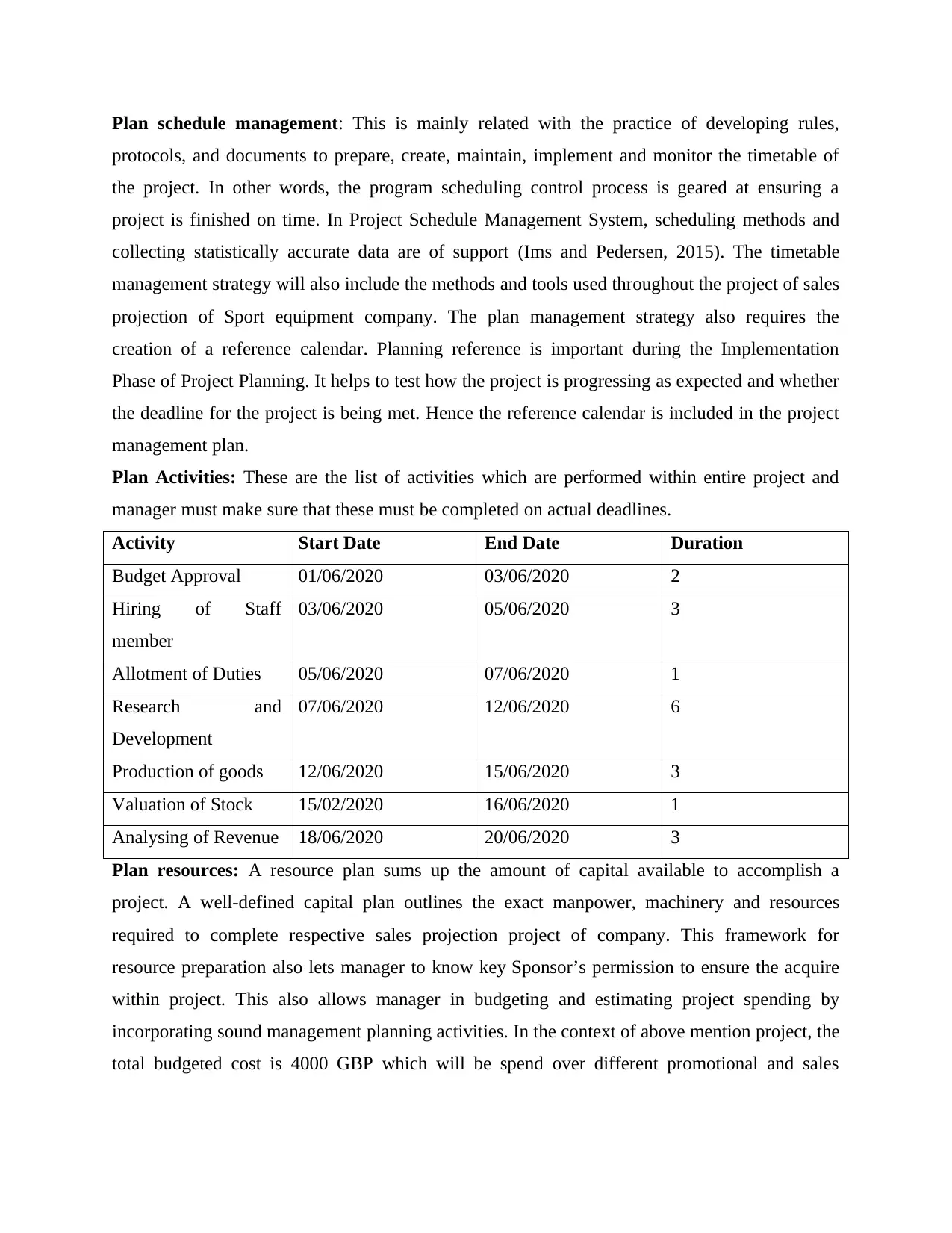
Plan schedule management: This is mainly related with the practice of developing rules,
protocols, and documents to prepare, create, maintain, implement and monitor the timetable of
the project. In other words, the program scheduling control process is geared at ensuring a
project is finished on time. In Project Schedule Management System, scheduling methods and
collecting statistically accurate data are of support (Ims and Pedersen, 2015). The timetable
management strategy will also include the methods and tools used throughout the project of sales
projection of Sport equipment company. The plan management strategy also requires the
creation of a reference calendar. Planning reference is important during the Implementation
Phase of Project Planning. It helps to test how the project is progressing as expected and whether
the deadline for the project is being met. Hence the reference calendar is included in the project
management plan.
Plan Activities: These are the list of activities which are performed within entire project and
manager must make sure that these must be completed on actual deadlines.
Activity Start Date End Date Duration
Budget Approval 01/06/2020 03/06/2020 2
Hiring of Staff
member
03/06/2020 05/06/2020 3
Allotment of Duties 05/06/2020 07/06/2020 1
Research and
Development
07/06/2020 12/06/2020 6
Production of goods 12/06/2020 15/06/2020 3
Valuation of Stock 15/02/2020 16/06/2020 1
Analysing of Revenue 18/06/2020 20/06/2020 3
Plan resources: A resource plan sums up the amount of capital available to accomplish a
project. A well-defined capital plan outlines the exact manpower, machinery and resources
required to complete respective sales projection project of company. This framework for
resource preparation also lets manager to know key Sponsor’s permission to ensure the acquire
within project. This also allows manager in budgeting and estimating project spending by
incorporating sound management planning activities. In the context of above mention project, the
total budgeted cost is 4000 GBP which will be spend over different promotional and sales
protocols, and documents to prepare, create, maintain, implement and monitor the timetable of
the project. In other words, the program scheduling control process is geared at ensuring a
project is finished on time. In Project Schedule Management System, scheduling methods and
collecting statistically accurate data are of support (Ims and Pedersen, 2015). The timetable
management strategy will also include the methods and tools used throughout the project of sales
projection of Sport equipment company. The plan management strategy also requires the
creation of a reference calendar. Planning reference is important during the Implementation
Phase of Project Planning. It helps to test how the project is progressing as expected and whether
the deadline for the project is being met. Hence the reference calendar is included in the project
management plan.
Plan Activities: These are the list of activities which are performed within entire project and
manager must make sure that these must be completed on actual deadlines.
Activity Start Date End Date Duration
Budget Approval 01/06/2020 03/06/2020 2
Hiring of Staff
member
03/06/2020 05/06/2020 3
Allotment of Duties 05/06/2020 07/06/2020 1
Research and
Development
07/06/2020 12/06/2020 6
Production of goods 12/06/2020 15/06/2020 3
Valuation of Stock 15/02/2020 16/06/2020 1
Analysing of Revenue 18/06/2020 20/06/2020 3
Plan resources: A resource plan sums up the amount of capital available to accomplish a
project. A well-defined capital plan outlines the exact manpower, machinery and resources
required to complete respective sales projection project of company. This framework for
resource preparation also lets manager to know key Sponsor’s permission to ensure the acquire
within project. This also allows manager in budgeting and estimating project spending by
incorporating sound management planning activities. In the context of above mention project, the
total budgeted cost is 4000 GBP which will be spend over different promotional and sales
⊘ This is a preview!⊘
Do you want full access?
Subscribe today to unlock all pages.

Trusted by 1+ million students worldwide
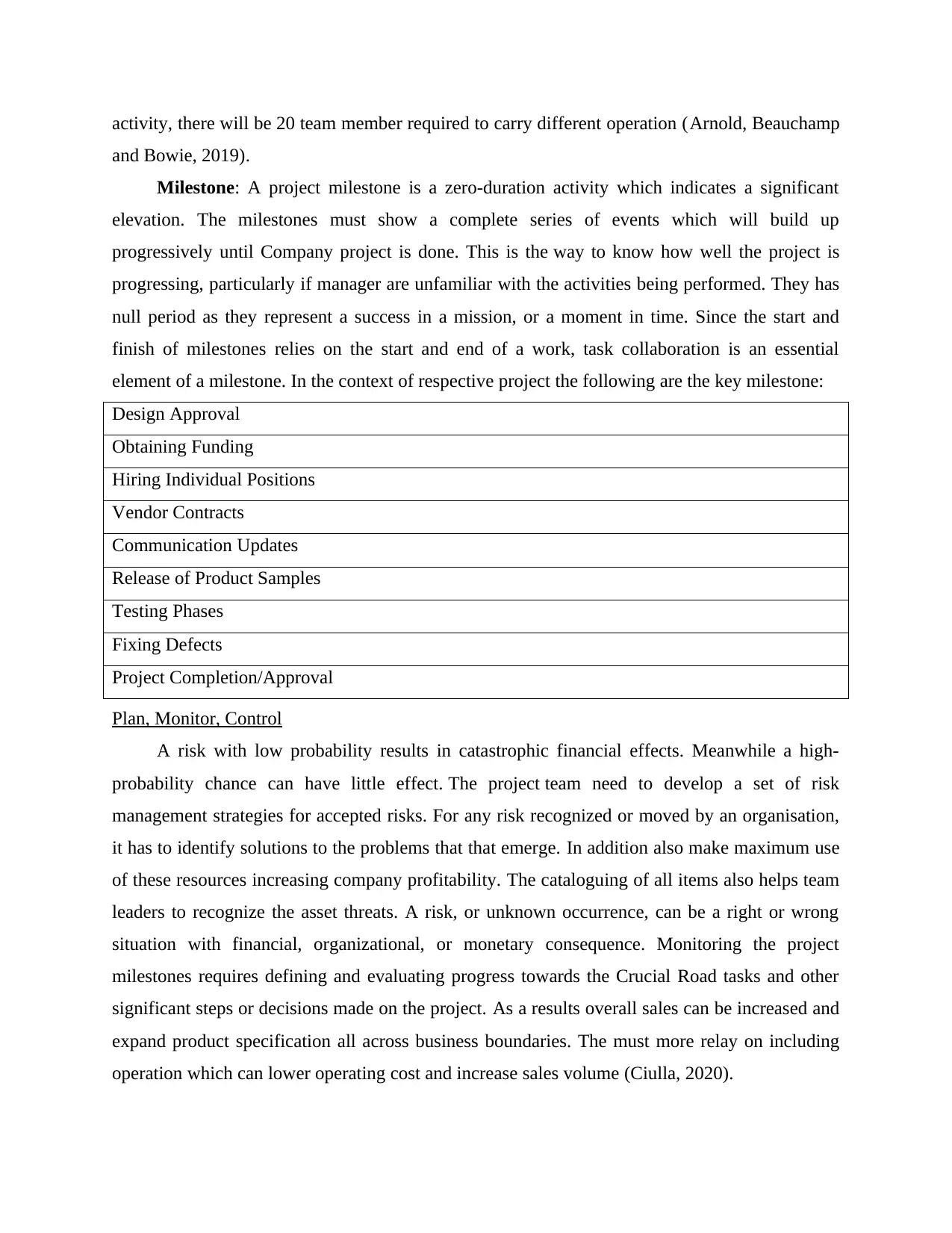
activity, there will be 20 team member required to carry different operation (Arnold, Beauchamp
and Bowie, 2019).
Milestone: A project milestone is a zero-duration activity which indicates a significant
elevation. The milestones must show a complete series of events which will build up
progressively until Company project is done. This is the way to know how well the project is
progressing, particularly if manager are unfamiliar with the activities being performed. They has
null period as they represent a success in a mission, or a moment in time. Since the start and
finish of milestones relies on the start and end of a work, task collaboration is an essential
element of a milestone. In the context of respective project the following are the key milestone:
Design Approval
Obtaining Funding
Hiring Individual Positions
Vendor Contracts
Communication Updates
Release of Product Samples
Testing Phases
Fixing Defects
Project Completion/Approval
Plan, Monitor, Control
A risk with low probability results in catastrophic financial effects. Meanwhile a high-
probability chance can have little effect. The project team need to develop a set of risk
management strategies for accepted risks. For any risk recognized or moved by an organisation,
it has to identify solutions to the problems that that emerge. In addition also make maximum use
of these resources increasing company profitability. The cataloguing of all items also helps team
leaders to recognize the asset threats. A risk, or unknown occurrence, can be a right or wrong
situation with financial, organizational, or monetary consequence. Monitoring the project
milestones requires defining and evaluating progress towards the Crucial Road tasks and other
significant steps or decisions made on the project. As a results overall sales can be increased and
expand product specification all across business boundaries. The must more relay on including
operation which can lower operating cost and increase sales volume (Ciulla, 2020).
and Bowie, 2019).
Milestone: A project milestone is a zero-duration activity which indicates a significant
elevation. The milestones must show a complete series of events which will build up
progressively until Company project is done. This is the way to know how well the project is
progressing, particularly if manager are unfamiliar with the activities being performed. They has
null period as they represent a success in a mission, or a moment in time. Since the start and
finish of milestones relies on the start and end of a work, task collaboration is an essential
element of a milestone. In the context of respective project the following are the key milestone:
Design Approval
Obtaining Funding
Hiring Individual Positions
Vendor Contracts
Communication Updates
Release of Product Samples
Testing Phases
Fixing Defects
Project Completion/Approval
Plan, Monitor, Control
A risk with low probability results in catastrophic financial effects. Meanwhile a high-
probability chance can have little effect. The project team need to develop a set of risk
management strategies for accepted risks. For any risk recognized or moved by an organisation,
it has to identify solutions to the problems that that emerge. In addition also make maximum use
of these resources increasing company profitability. The cataloguing of all items also helps team
leaders to recognize the asset threats. A risk, or unknown occurrence, can be a right or wrong
situation with financial, organizational, or monetary consequence. Monitoring the project
milestones requires defining and evaluating progress towards the Crucial Road tasks and other
significant steps or decisions made on the project. As a results overall sales can be increased and
expand product specification all across business boundaries. The must more relay on including
operation which can lower operating cost and increase sales volume (Ciulla, 2020).
Paraphrase This Document
Need a fresh take? Get an instant paraphrase of this document with our AI Paraphraser
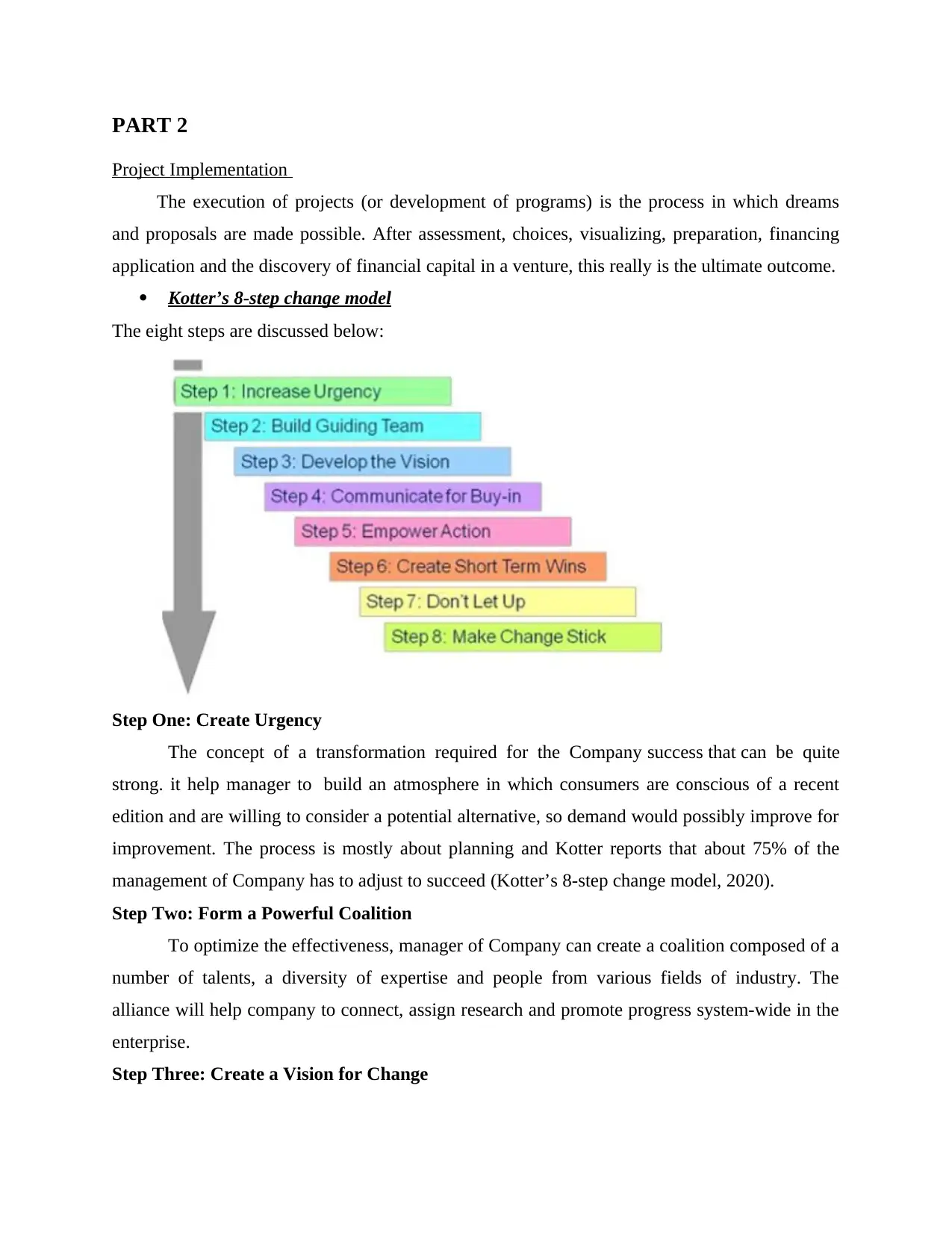
PART 2
Project Implementation
The execution of projects (or development of programs) is the process in which dreams
and proposals are made possible. After assessment, choices, visualizing, preparation, financing
application and the discovery of financial capital in a venture, this really is the ultimate outcome.
Kotter’s 8-step change model
The eight steps are discussed below:
Step One: Create Urgency
The concept of a transformation required for the Company success that can be quite
strong. it help manager to build an atmosphere in which consumers are conscious of a recent
edition and are willing to consider a potential alternative, so demand would possibly improve for
improvement. The process is mostly about planning and Kotter reports that about 75% of the
management of Company has to adjust to succeed (Kotter’s 8-step change model, 2020).
Step Two: Form a Powerful Coalition
To optimize the effectiveness, manager of Company can create a coalition composed of a
number of talents, a diversity of expertise and people from various fields of industry. The
alliance will help company to connect, assign research and promote progress system-wide in the
enterprise.
Step Three: Create a Vision for Change
Project Implementation
The execution of projects (or development of programs) is the process in which dreams
and proposals are made possible. After assessment, choices, visualizing, preparation, financing
application and the discovery of financial capital in a venture, this really is the ultimate outcome.
Kotter’s 8-step change model
The eight steps are discussed below:
Step One: Create Urgency
The concept of a transformation required for the Company success that can be quite
strong. it help manager to build an atmosphere in which consumers are conscious of a recent
edition and are willing to consider a potential alternative, so demand would possibly improve for
improvement. The process is mostly about planning and Kotter reports that about 75% of the
management of Company has to adjust to succeed (Kotter’s 8-step change model, 2020).
Step Two: Form a Powerful Coalition
To optimize the effectiveness, manager of Company can create a coalition composed of a
number of talents, a diversity of expertise and people from various fields of industry. The
alliance will help company to connect, assign research and promote progress system-wide in the
enterprise.
Step Three: Create a Vision for Change
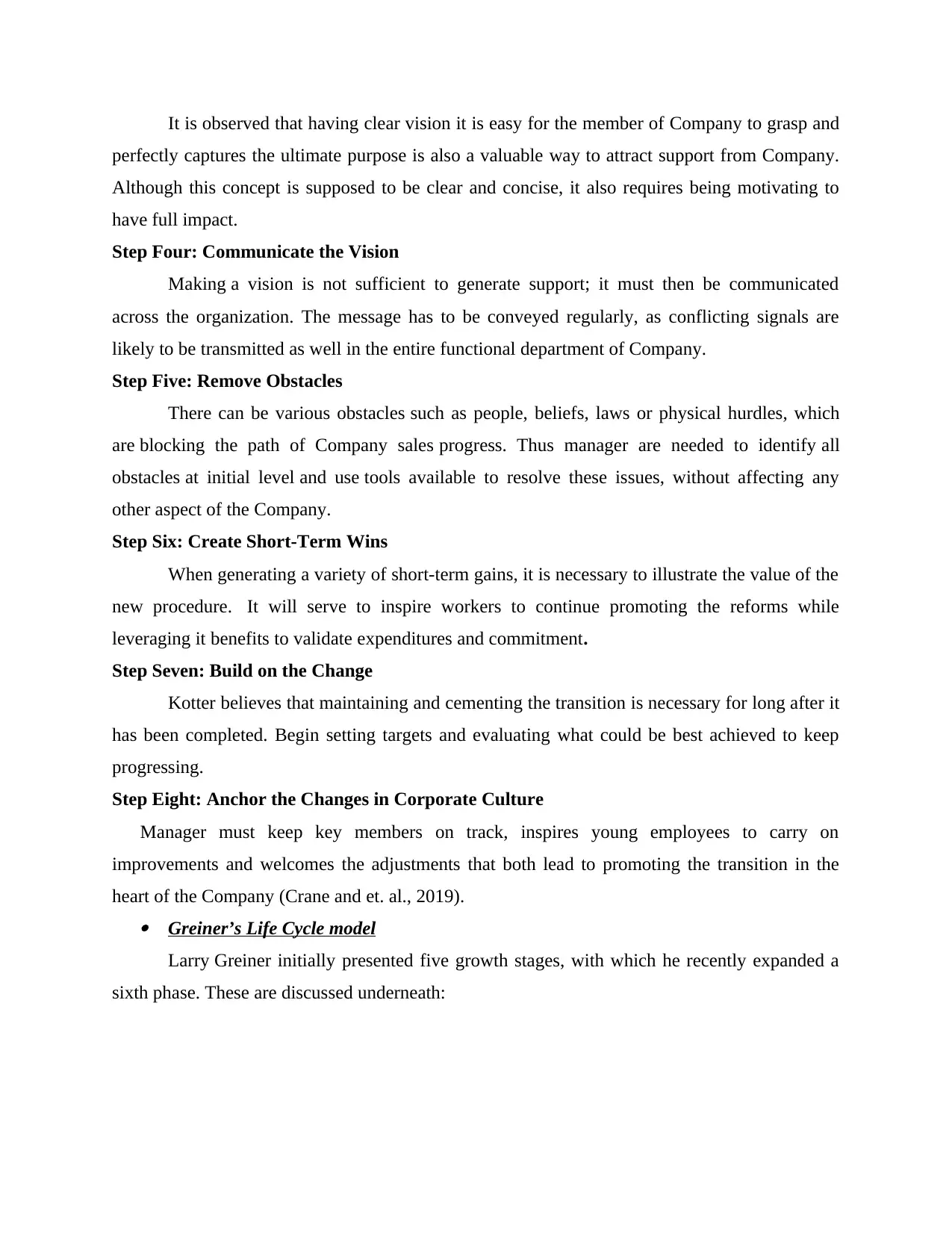
It is observed that having clear vision it is easy for the member of Company to grasp and
perfectly captures the ultimate purpose is also a valuable way to attract support from Company.
Although this concept is supposed to be clear and concise, it also requires being motivating to
have full impact.
Step Four: Communicate the Vision
Making a vision is not sufficient to generate support; it must then be communicated
across the organization. The message has to be conveyed regularly, as conflicting signals are
likely to be transmitted as well in the entire functional department of Company.
Step Five: Remove Obstacles
There can be various obstacles such as people, beliefs, laws or physical hurdles, which
are blocking the path of Company sales progress. Thus manager are needed to identify all
obstacles at initial level and use tools available to resolve these issues, without affecting any
other aspect of the Company.
Step Six: Create Short-Term Wins
When generating a variety of short-term gains, it is necessary to illustrate the value of the
new procedure. It will serve to inspire workers to continue promoting the reforms while
leveraging it benefits to validate expenditures and commitment.
Step Seven: Build on the Change
Kotter believes that maintaining and cementing the transition is necessary for long after it
has been completed. Begin setting targets and evaluating what could be best achieved to keep
progressing.
Step Eight: Anchor the Changes in Corporate Culture
Manager must keep key members on track, inspires young employees to carry on
improvements and welcomes the adjustments that both lead to promoting the transition in the
heart of the Company (Crane and et. al., 2019). Greiner’s Life Cycle model
Larry Greiner initially presented five growth stages, with which he recently expanded a
sixth phase. These are discussed underneath:
perfectly captures the ultimate purpose is also a valuable way to attract support from Company.
Although this concept is supposed to be clear and concise, it also requires being motivating to
have full impact.
Step Four: Communicate the Vision
Making a vision is not sufficient to generate support; it must then be communicated
across the organization. The message has to be conveyed regularly, as conflicting signals are
likely to be transmitted as well in the entire functional department of Company.
Step Five: Remove Obstacles
There can be various obstacles such as people, beliefs, laws or physical hurdles, which
are blocking the path of Company sales progress. Thus manager are needed to identify all
obstacles at initial level and use tools available to resolve these issues, without affecting any
other aspect of the Company.
Step Six: Create Short-Term Wins
When generating a variety of short-term gains, it is necessary to illustrate the value of the
new procedure. It will serve to inspire workers to continue promoting the reforms while
leveraging it benefits to validate expenditures and commitment.
Step Seven: Build on the Change
Kotter believes that maintaining and cementing the transition is necessary for long after it
has been completed. Begin setting targets and evaluating what could be best achieved to keep
progressing.
Step Eight: Anchor the Changes in Corporate Culture
Manager must keep key members on track, inspires young employees to carry on
improvements and welcomes the adjustments that both lead to promoting the transition in the
heart of the Company (Crane and et. al., 2019). Greiner’s Life Cycle model
Larry Greiner initially presented five growth stages, with which he recently expanded a
sixth phase. These are discussed underneath:
⊘ This is a preview!⊘
Do you want full access?
Subscribe today to unlock all pages.

Trusted by 1+ million students worldwide
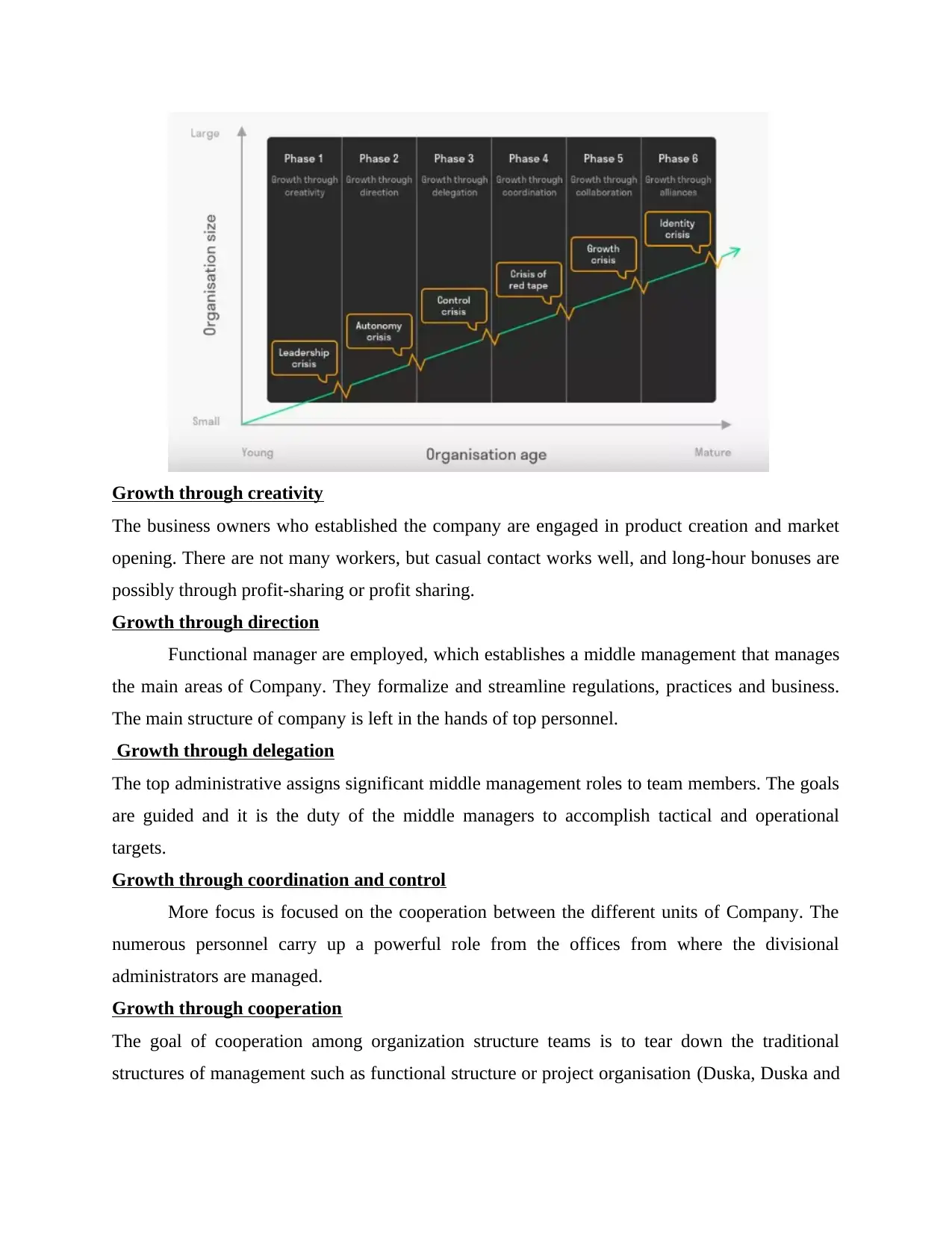
Growth through creativity
The business owners who established the company are engaged in product creation and market
opening. There are not many workers, but casual contact works well, and long-hour bonuses are
possibly through profit-sharing or profit sharing.
Growth through direction
Functional manager are employed, which establishes a middle management that manages
the main areas of Company. They formalize and streamline regulations, practices and business.
The main structure of company is left in the hands of top personnel.
Growth through delegation
The top administrative assigns significant middle management roles to team members. The goals
are guided and it is the duty of the middle managers to accomplish tactical and operational
targets.
Growth through coordination and control
More focus is focused on the cooperation between the different units of Company. The
numerous personnel carry up a powerful role from the offices from where the divisional
administrators are managed.
Growth through cooperation
The goal of cooperation among organization structure teams is to tear down the traditional
structures of management such as functional structure or project organisation (Duska, Duska and
The business owners who established the company are engaged in product creation and market
opening. There are not many workers, but casual contact works well, and long-hour bonuses are
possibly through profit-sharing or profit sharing.
Growth through direction
Functional manager are employed, which establishes a middle management that manages
the main areas of Company. They formalize and streamline regulations, practices and business.
The main structure of company is left in the hands of top personnel.
Growth through delegation
The top administrative assigns significant middle management roles to team members. The goals
are guided and it is the duty of the middle managers to accomplish tactical and operational
targets.
Growth through coordination and control
More focus is focused on the cooperation between the different units of Company. The
numerous personnel carry up a powerful role from the offices from where the divisional
administrators are managed.
Growth through cooperation
The goal of cooperation among organization structure teams is to tear down the traditional
structures of management such as functional structure or project organisation (Duska, Duska and
Paraphrase This Document
Need a fresh take? Get an instant paraphrase of this document with our AI Paraphraser
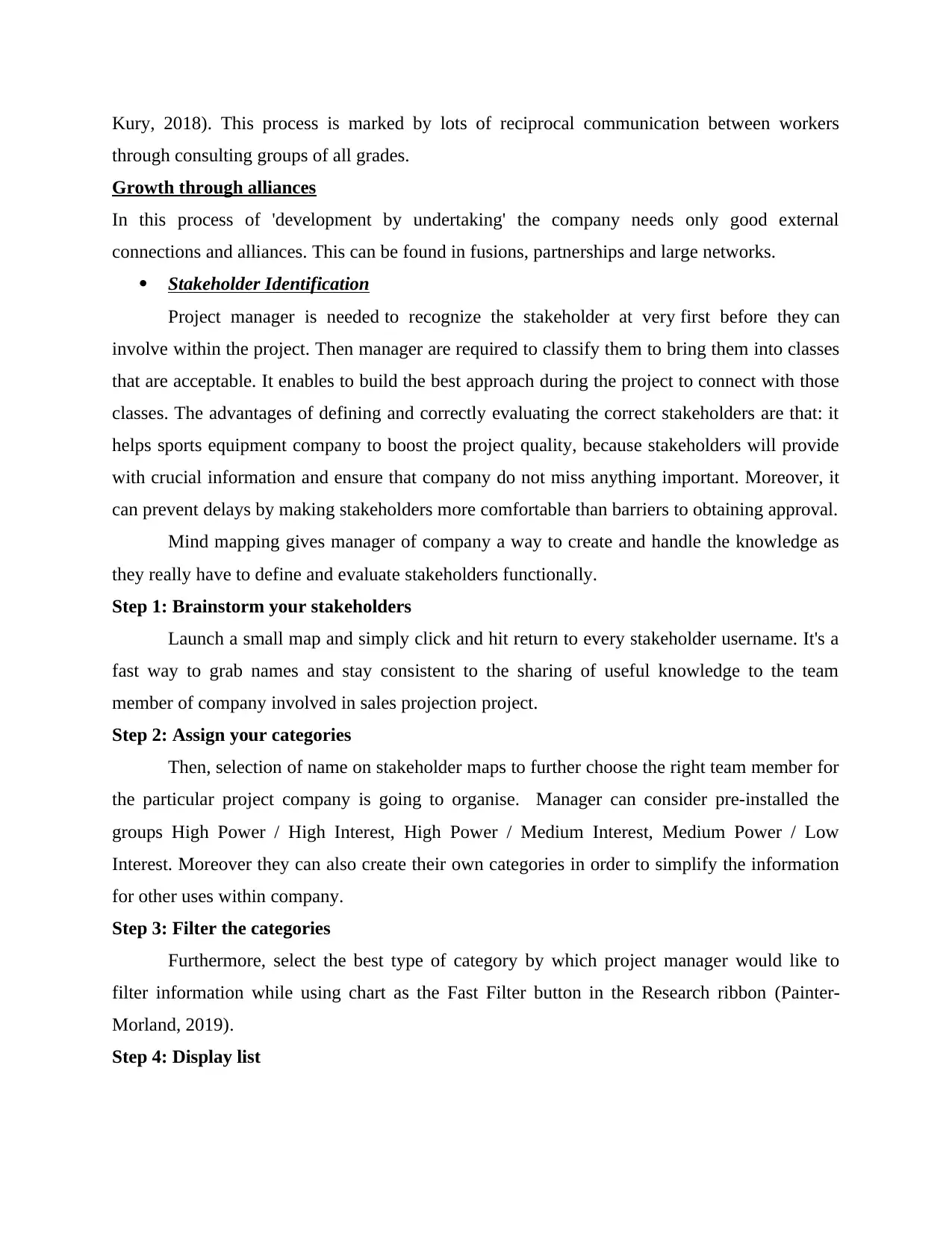
Kury, 2018). This process is marked by lots of reciprocal communication between workers
through consulting groups of all grades.
Growth through alliances
In this process of 'development by undertaking' the company needs only good external
connections and alliances. This can be found in fusions, partnerships and large networks.
Stakeholder Identification
Project manager is needed to recognize the stakeholder at very first before they can
involve within the project. Then manager are required to classify them to bring them into classes
that are acceptable. It enables to build the best approach during the project to connect with those
classes. The advantages of defining and correctly evaluating the correct stakeholders are that: it
helps sports equipment company to boost the project quality, because stakeholders will provide
with crucial information and ensure that company do not miss anything important. Moreover, it
can prevent delays by making stakeholders more comfortable than barriers to obtaining approval.
Mind mapping gives manager of company a way to create and handle the knowledge as
they really have to define and evaluate stakeholders functionally.
Step 1: Brainstorm your stakeholders
Launch a small map and simply click and hit return to every stakeholder username. It's a
fast way to grab names and stay consistent to the sharing of useful knowledge to the team
member of company involved in sales projection project.
Step 2: Assign your categories
Then, selection of name on stakeholder maps to further choose the right team member for
the particular project company is going to organise. Manager can consider pre-installed the
groups High Power / High Interest, High Power / Medium Interest, Medium Power / Low
Interest. Moreover they can also create their own categories in order to simplify the information
for other uses within company.
Step 3: Filter the categories
Furthermore, select the best type of category by which project manager would like to
filter information while using chart as the Fast Filter button in the Research ribbon (Painter-
Morland, 2019).
Step 4: Display list
through consulting groups of all grades.
Growth through alliances
In this process of 'development by undertaking' the company needs only good external
connections and alliances. This can be found in fusions, partnerships and large networks.
Stakeholder Identification
Project manager is needed to recognize the stakeholder at very first before they can
involve within the project. Then manager are required to classify them to bring them into classes
that are acceptable. It enables to build the best approach during the project to connect with those
classes. The advantages of defining and correctly evaluating the correct stakeholders are that: it
helps sports equipment company to boost the project quality, because stakeholders will provide
with crucial information and ensure that company do not miss anything important. Moreover, it
can prevent delays by making stakeholders more comfortable than barriers to obtaining approval.
Mind mapping gives manager of company a way to create and handle the knowledge as
they really have to define and evaluate stakeholders functionally.
Step 1: Brainstorm your stakeholders
Launch a small map and simply click and hit return to every stakeholder username. It's a
fast way to grab names and stay consistent to the sharing of useful knowledge to the team
member of company involved in sales projection project.
Step 2: Assign your categories
Then, selection of name on stakeholder maps to further choose the right team member for
the particular project company is going to organise. Manager can consider pre-installed the
groups High Power / High Interest, High Power / Medium Interest, Medium Power / Low
Interest. Moreover they can also create their own categories in order to simplify the information
for other uses within company.
Step 3: Filter the categories
Furthermore, select the best type of category by which project manager would like to
filter information while using chart as the Fast Filter button in the Research ribbon (Painter-
Morland, 2019).
Step 4: Display list
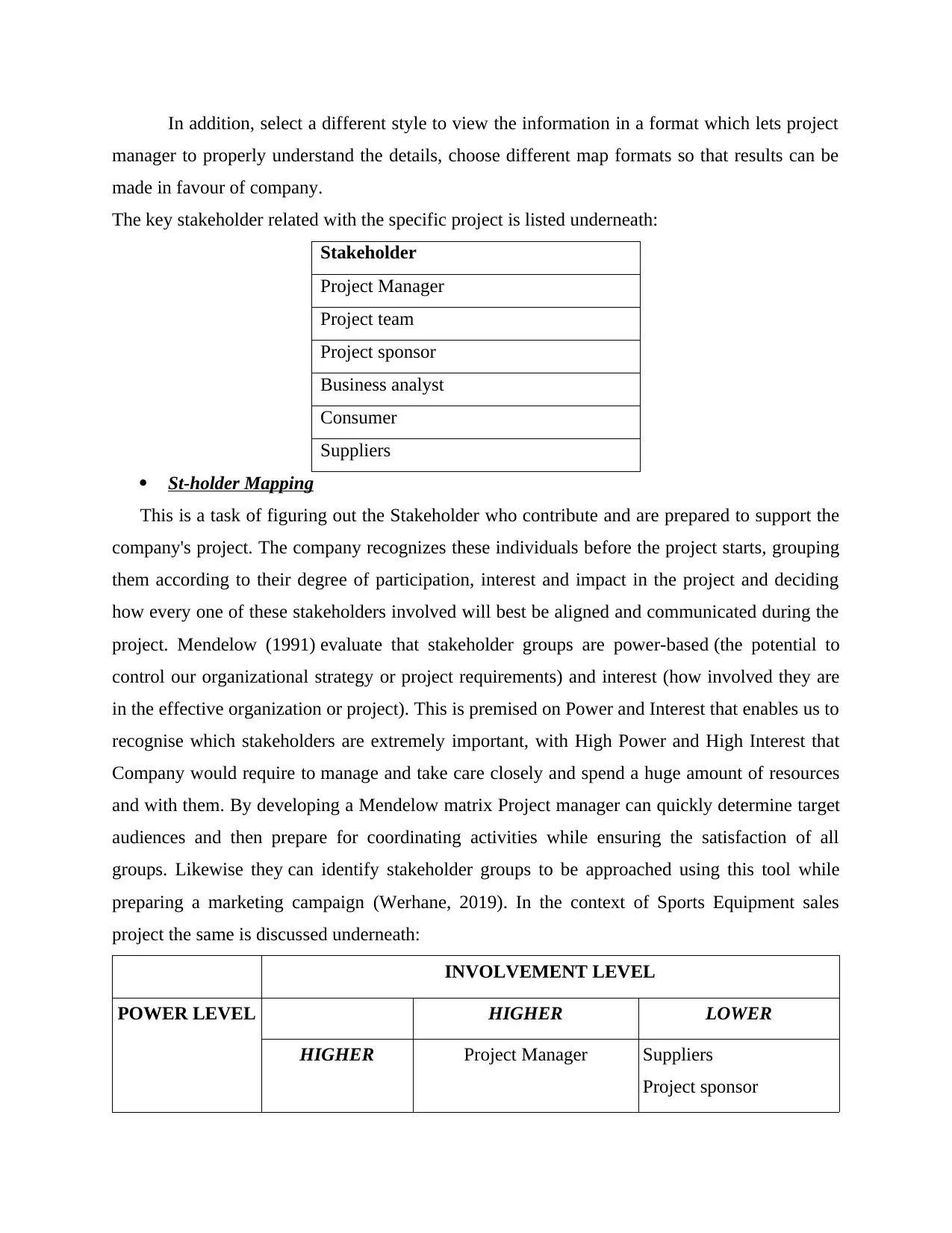
In addition, select a different style to view the information in a format which lets project
manager to properly understand the details, choose different map formats so that results can be
made in favour of company.
The key stakeholder related with the specific project is listed underneath:
Stakeholder
Project Manager
Project team
Project sponsor
Business analyst
Consumer
Suppliers
St-holder Mapping
This is a task of figuring out the Stakeholder who contribute and are prepared to support the
company's project. The company recognizes these individuals before the project starts, grouping
them according to their degree of participation, interest and impact in the project and deciding
how every one of these stakeholders involved will best be aligned and communicated during the
project. Mendelow (1991) evaluate that stakeholder groups are power-based (the potential to
control our organizational strategy or project requirements) and interest (how involved they are
in the effective organization or project). This is premised on Power and Interest that enables us to
recognise which stakeholders are extremely important, with High Power and High Interest that
Company would require to manage and take care closely and spend a huge amount of resources
and with them. By developing a Mendelow matrix Project manager can quickly determine target
audiences and then prepare for coordinating activities while ensuring the satisfaction of all
groups. Likewise they can identify stakeholder groups to be approached using this tool while
preparing a marketing campaign (Werhane, 2019). In the context of Sports Equipment sales
project the same is discussed underneath:
INVOLVEMENT LEVEL
POWER LEVEL HIGHER LOWER
HIGHER Project Manager Suppliers
Project sponsor
manager to properly understand the details, choose different map formats so that results can be
made in favour of company.
The key stakeholder related with the specific project is listed underneath:
Stakeholder
Project Manager
Project team
Project sponsor
Business analyst
Consumer
Suppliers
St-holder Mapping
This is a task of figuring out the Stakeholder who contribute and are prepared to support the
company's project. The company recognizes these individuals before the project starts, grouping
them according to their degree of participation, interest and impact in the project and deciding
how every one of these stakeholders involved will best be aligned and communicated during the
project. Mendelow (1991) evaluate that stakeholder groups are power-based (the potential to
control our organizational strategy or project requirements) and interest (how involved they are
in the effective organization or project). This is premised on Power and Interest that enables us to
recognise which stakeholders are extremely important, with High Power and High Interest that
Company would require to manage and take care closely and spend a huge amount of resources
and with them. By developing a Mendelow matrix Project manager can quickly determine target
audiences and then prepare for coordinating activities while ensuring the satisfaction of all
groups. Likewise they can identify stakeholder groups to be approached using this tool while
preparing a marketing campaign (Werhane, 2019). In the context of Sports Equipment sales
project the same is discussed underneath:
INVOLVEMENT LEVEL
POWER LEVEL HIGHER LOWER
HIGHER Project Manager Suppliers
Project sponsor
⊘ This is a preview!⊘
Do you want full access?
Subscribe today to unlock all pages.

Trusted by 1+ million students worldwide
1 out of 19
Related Documents
Your All-in-One AI-Powered Toolkit for Academic Success.
+13062052269
info@desklib.com
Available 24*7 on WhatsApp / Email
![[object Object]](/_next/static/media/star-bottom.7253800d.svg)
Unlock your academic potential
Copyright © 2020–2025 A2Z Services. All Rights Reserved. Developed and managed by ZUCOL.





